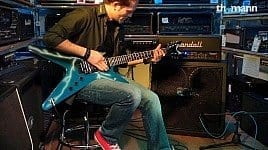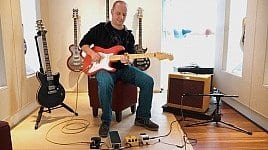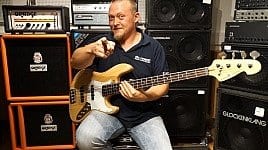
Cliff Burton was one of the most influential bassists in the history of metal, but unfortunately he left us way too soon. Between 1982 and 1986, he left his mark in the thrash metal scene together with Metallica, during which he developed his own dirty bass-sound of which we dedicate our latest “One Way To Sound Like…”
You are currently viewing a placeholder content from YouTube. To access the actual content, click the button below. Please note that doing so will share data with third-party providers.
A good place to start is of course among the bass candidates in our Thomann shop. In the video Andi plays the Rickenbacker 4003S MG of which we consider to be the closest to the original sound. Alternatively we also played the Fender Precision, the 50s Classics and Mexico Standards. The single coils are noticeably key in contributing to the overall sound.
The Orange OB1-500 bass head is able to deliver that necessary power and dirt in the drive sound, as long as you don’t skimp on the volume 😉 Slightly turn down the bass and turn up the mids and you’re good to go. Some good alternatives would be for e.g the Ampeg BA V2 series and as always the Ampeg Heritage SVT-CL does a fantastic a job.
As for the cabinet we chose the Ampeg PF-410HLF which delivers the perfect punch thanks to the ceramic Eminence LF speakers. As for those, who aren’t afraid to step it up a notch, we bring forth the Ampeg Heritage SVT810E. Cliff wasn’t big on using many different effects, but the effects he did use, he used intensely. Obviously we chose the Morley M2 Cliff Burton Fuzz Wah with massive sustain, capable of triggering a very aggressive Fuzz, especially when coupled with the Little Big Muff. Alternatively you can combine the Nano Bass Big Muff with a Dunlop Bass Mini Wah and a Boss CS-3 compressor.
As always we would like to point out that gear alone is not enough and should of course be accompanied with a bit of practice. Cliff, for instance played with his fingers close to the bridge. Have you already attempted to reproduce Cliff’s sound? What equipment did you use?
6 comments
Leave a Reply
You are currently viewing a placeholder content from Facebook. To access the actual content, click the button below. Please note that doing so will share data with third-party providers.
More InformationYou are currently viewing a placeholder content from Instagram. To access the actual content, click the button below. Please note that doing so will share data with third-party providers.
More InformationYou are currently viewing a placeholder content from X. To access the actual content, click the button below. Please note that doing so will share data with third-party providers.
More Information

















Kaleb Smith says:
And not to mention the fact that you used a Big Muff and the CS-3 Compression Sustainer. He traded the Big Muff Pi for the TS-808 Tube Screamer in ’83. And he never even had a CS-3. He had a CS-2.
steven gensel says:
Well Kaleb, they don’t make the CS-2 anymore, so that’s why they used a cs3, think dude.
Clifford Bao says:
Actually, while Cliff did use a 4001 Rickenbacker he had replaced the Neck Pickup with a Humbucker from a Gibson EB-0, so if you try this again I would suggest that, as for the other Pickups Cliff used in his Bass, he had a Seymour Duncan Stacked Jazz Pickup in the Bridge and in the cavern under the Bridge where the foam mute was supposed to be he put a Seymour Duncan Stacked Strat pickup that was activated by a push/pull knob.
I know you’re trying to be affordable but maybe just mention these if you do this again.
Also: next time we’d like more specific Amp Settings.
Tom Lever says:
Clifford Bao I understand and agree with you completely but the humbucker thing but they probably didn’t mention it as the my don’t won’t people to go out and buy an expensive bass ( rickenbackers are about $3,000) and then cut a hole in it and ruin it
Saroja says:
cool, as a 13 year old bass player I cannot afford any of this but yay!
Joe says:
Keep on practicing and one day you’ll be able to afford it 🙂 We believe in you! //Your Thomann Team